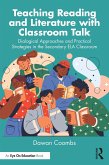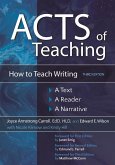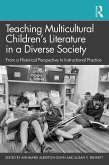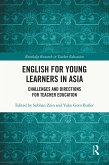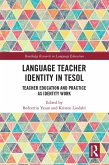Breakthroughs in College Reading (eBook, PDF)
The Promises and Tensions of Disciplinary Reading Apprenticeships
Redaktion: Graff, Nelson; Kersnar, Rebecca; Hogan, Nika
26,95 €
26,95 €
inkl. MwSt.
Sofort per Download lieferbar

13 °P sammeln
26,95 €
Als Download kaufen

26,95 €
inkl. MwSt.
Sofort per Download lieferbar

13 °P sammeln
Jetzt verschenken
Alle Infos zum eBook verschenken
26,95 €
inkl. MwSt.
Sofort per Download lieferbar
Alle Infos zum eBook verschenken

13 °P sammeln
Breakthroughs in College Reading (eBook, PDF)
The Promises and Tensions of Disciplinary Reading Apprenticeships
Redaktion: Graff, Nelson; Kersnar, Rebecca; Hogan, Nika
- Format: PDF
- Merkliste
- Auf die Merkliste
- Bewerten Bewerten
- Teilen
- Produkt teilen
- Produkterinnerung
- Produkterinnerung

Bitte loggen Sie sich zunächst in Ihr Kundenkonto ein oder registrieren Sie sich bei
bücher.de, um das eBook-Abo tolino select nutzen zu können.
Hier können Sie sich einloggen
Hier können Sie sich einloggen
Sie sind bereits eingeloggt. Klicken Sie auf 2. tolino select Abo, um fortzufahren.

Bitte loggen Sie sich zunächst in Ihr Kundenkonto ein oder registrieren Sie sich bei bücher.de, um das eBook-Abo tolino select nutzen zu können.
How do we help college students become independent learners in their disciplines? In this collection, the editors and contributors argue that we do so by supporting students in learning from texts, which entails recognizing reading as a problem-solving process, supporting students to take responsibility for the intellectual work in their classes, and creating strong classroom communities that help students develop identities as scholars.
- Geräte: PC
- mit Kopierschutz
- eBook Hilfe
- Größe: 5.3MB
Andere Kunden interessierten sich auch für
![Teach This Poem, Volume I (eBook, PDF) Teach This Poem, Volume I (eBook, PDF)]() Madeleine Fuchs HolzerTeach This Poem, Volume I (eBook, PDF)28,95 €
Madeleine Fuchs HolzerTeach This Poem, Volume I (eBook, PDF)28,95 €![Teaching Reading and Literature with Classroom Talk (eBook, PDF) Teaching Reading and Literature with Classroom Talk (eBook, PDF)]() Dawan CoombsTeaching Reading and Literature with Classroom Talk (eBook, PDF)26,95 €
Dawan CoombsTeaching Reading and Literature with Classroom Talk (eBook, PDF)26,95 €![Acts of Teaching (eBook, PDF) Acts of Teaching (eBook, PDF)]() Joyce Armstrong CarrollActs of Teaching (eBook, PDF)42,95 €
Joyce Armstrong CarrollActs of Teaching (eBook, PDF)42,95 €![Teaching Multicultural Children's Literature in a Diverse Society (eBook, PDF) Teaching Multicultural Children's Literature in a Diverse Society (eBook, PDF)]() Teaching Multicultural Children's Literature in a Diverse Society (eBook, PDF)37,95 €
Teaching Multicultural Children's Literature in a Diverse Society (eBook, PDF)37,95 €![English for Young Learners in Asia (eBook, PDF) English for Young Learners in Asia (eBook, PDF)]() English for Young Learners in Asia (eBook, PDF)39,95 €
English for Young Learners in Asia (eBook, PDF)39,95 €![Language Teacher Identity in TESOL (eBook, PDF) Language Teacher Identity in TESOL (eBook, PDF)]() Language Teacher Identity in TESOL (eBook, PDF)39,95 €
Language Teacher Identity in TESOL (eBook, PDF)39,95 €![Sentence Strategies for Multilingual Learners (eBook, PDF) Sentence Strategies for Multilingual Learners (eBook, PDF)]() Nell Scharff PaneroSentence Strategies for Multilingual Learners (eBook, PDF)28,95 €
Nell Scharff PaneroSentence Strategies for Multilingual Learners (eBook, PDF)28,95 €-
-
-
How do we help college students become independent learners in their disciplines? In this collection, the editors and contributors argue that we do so by supporting students in learning from texts, which entails recognizing reading as a problem-solving process, supporting students to take responsibility for the intellectual work in their classes, and creating strong classroom communities that help students develop identities as scholars.
Produktdetails
- Produktdetails
- Verlag: Bloomsbury eBooks US
- Seitenzahl: 244
- Erscheinungstermin: 5. September 2024
- Englisch
- ISBN-13: 9798881855406
- Artikelnr.: 74834704
- Verlag: Bloomsbury eBooks US
- Seitenzahl: 244
- Erscheinungstermin: 5. September 2024
- Englisch
- ISBN-13: 9798881855406
- Artikelnr.: 74834704
- Herstellerkennzeichnung Die Herstellerinformationen sind derzeit nicht verfügbar.
Nelson Graff A former high-school English teacher, Nelson taught English Education from 2000-2015 and is now retired from teaching first-year composition and working with faculty across the disciplines in improving reading and writing instruction. He is a member of the steering committee for the CSU Expository Reading and Writing Curriculum (ERWC) and the CSU English Council. His research focuses on teaching for transfer of learning, reading and writing pedagogy, and assessment. He has a BA in English from San José State University, an MA in English and American Literature and a PhD in Composition Studies from the University of Wisconsin-Madison. Nika Hogan Nika Hogan is a Professor of English at Pasadena City College (PCC). She helped to develop the First Year Pathways program at PCC, which was awarded the California Community Colleges Chancellor's Office Award for a Student Success Initiative. Since an intensive period of learning and apprenticeship from 2007-2010, she has coordinated the college level work on Reading Apprenticeship for WestEd. From 2011-2023, she supported the California Community Colleges Success network (3CSN) to design and facilitate professional learning for educators across the 116 California community colleges. Her passion is building capacity and helping educators and students alike reach their full potential. She holds an MA and PhD in English with a focus on U.S. multi-ethnic literatures. She lives in Altadena, California with her wife, teenage son, and two incorrigiable terrier mutts. Rebecca Kersnar Rebecca Kersnar supports faculty across disciplines as the teaching and learning specialist with the Center for Teaching, Learning, and Assessment (TLA) at CSU, Monterey Bay. Before joining TLA, she served for over 14 years as a science and environmental policy communications lecturer with the College of Science. Before then she taught elementary through graduate students in San Francisco, Korea, Hungary, Thailand, and Mexico. Rebecca has a BS in Biology, concentration Botany from San Francisco State University and an MA in TESOL and certificate in Language Program Administration from the Middlebury Institute of International Studies. She is also a campus Reading Apprenticeship lead, certified Koru Mindfulness teacher, and National Coalition Building Institute facilitator. At CSUMB her work focuses primarily on reading and writing pedagogy, mindfulness and meditation, and equity.
Preface
Acknowledgments
Introduction: Making Visible Disciplinary Learning: Faculty Crossing
Thresholds to Support College Reading (Nelson Graff, Nika Hogan, and
Rebecca Kersnar)
Part I: What is Reading Apprenticeship?
Chapter 1: Making It Real: Reading Apprenticeship in College (Nika Hogan)
Chapter 2: The College STEM Reading Apprenticeship Classroom (Theresa
Martin)
Chapter 3: Exponential, Not Linear: Designing for the Four Dimensions in
Noncredit ESL (Tiffany Ingle)
Chapter 4: Peer Educators as Reading Apprenticeship Practitioners (Crystal
Kiekel)
Part II: Equity Matters: Tensions of Academic Apprenticeship
Chapter 5: Consciously Apprenticing Students (Lauren Servais)
Chapter 6: Culturally Responsive Teaching and Reading Apprenticeship: A
Conversation (Yhashika Lee, Salina Lopez, Ibrahim Shelton)
Part III: Reading is a Problem-Solving Process
Chapter 7: Reading Historically Through Metacognitive Logs (Christopher
Padgett)
Chapter 8: Not a White Rabbit-Reflection on Metacognitive Conversations and
TAPPS (Corin Slown)
Chapter 9: Reading into Information Literacy (Ryne Leuzinger)
Chapter 10: Equitable and Metacognitive Approaches to Library Sessions
(Anamika Megwalu)
Part IV: Students Must Be Entrusted with the Work of Making Sense of Texts
Chapter 11: Permission to Take Risk (Shelagh Rose)
Chapter 12: Reading in Calculus: Why, What, and How (Alison Lynch)
Chapter 13: Thinking Matters: Universal Design for Learning and Reading
Apprenticeship in Math (Kristen Purdum and Nika Hogan)
Chapter 14: The Role of the Productive Struggle in Authentic Learning: Why
Student Learning Insights Matter as Much as Student Learning Outcomes
(Shirley Kahlert)
Chapter 15: Introducing Perusall to Support Reading Apprenticeship in
Upper-Division Mathematics Courses in an Online Modality (Peri Shereen and
Jeffrey Wand)
Chapter 16: Snapshots of First-Year College Reading (Nanda Warren)
Part V: Reading is Social and Personal
Chapter 17: Feel-the-Text: A Metacognitive Reading Strategy where Readers
Make Emotions Visible (Sue Lee)
Chapter 18: Using the Reading Apprenticeship Framework to Change
College-Level Math Instruction (Christie Knighton)
Chapter 19: The Early Bird Special (Caren Kongshaug)
Chapter 20: Building Semester-Long Groups to Support the Social Dimension
of Learning and Problem Solving in the Large Biology Classroom (Erin
Stanfield)
Chapter 21: Restorative Pedagogy in Online Courses: Capitalizing on
Relationships through Reading Apprenticeship Routines (Andréa Pantoja
Garvey)
Chapter 22: Readers Wanna Read: Developing Self-Regulated Readers in the
Online Classroom (Julie Gamberg)
Chapter 23: Social Annotation as a Transdisciplinary Strategy for Engaging
Diverse Learners (Jonelle Strickland)
Chapter 24: The We and the Me: The Social and Personal Dimensions (Lora
Bagwell)
Chapter 25: It's Time to Eighty-Six the Old Menu (Aimee Beckstrom
Escalante)
Afterword
References
About the Authors
Acknowledgments
Introduction: Making Visible Disciplinary Learning: Faculty Crossing
Thresholds to Support College Reading (Nelson Graff, Nika Hogan, and
Rebecca Kersnar)
Part I: What is Reading Apprenticeship?
Chapter 1: Making It Real: Reading Apprenticeship in College (Nika Hogan)
Chapter 2: The College STEM Reading Apprenticeship Classroom (Theresa
Martin)
Chapter 3: Exponential, Not Linear: Designing for the Four Dimensions in
Noncredit ESL (Tiffany Ingle)
Chapter 4: Peer Educators as Reading Apprenticeship Practitioners (Crystal
Kiekel)
Part II: Equity Matters: Tensions of Academic Apprenticeship
Chapter 5: Consciously Apprenticing Students (Lauren Servais)
Chapter 6: Culturally Responsive Teaching and Reading Apprenticeship: A
Conversation (Yhashika Lee, Salina Lopez, Ibrahim Shelton)
Part III: Reading is a Problem-Solving Process
Chapter 7: Reading Historically Through Metacognitive Logs (Christopher
Padgett)
Chapter 8: Not a White Rabbit-Reflection on Metacognitive Conversations and
TAPPS (Corin Slown)
Chapter 9: Reading into Information Literacy (Ryne Leuzinger)
Chapter 10: Equitable and Metacognitive Approaches to Library Sessions
(Anamika Megwalu)
Part IV: Students Must Be Entrusted with the Work of Making Sense of Texts
Chapter 11: Permission to Take Risk (Shelagh Rose)
Chapter 12: Reading in Calculus: Why, What, and How (Alison Lynch)
Chapter 13: Thinking Matters: Universal Design for Learning and Reading
Apprenticeship in Math (Kristen Purdum and Nika Hogan)
Chapter 14: The Role of the Productive Struggle in Authentic Learning: Why
Student Learning Insights Matter as Much as Student Learning Outcomes
(Shirley Kahlert)
Chapter 15: Introducing Perusall to Support Reading Apprenticeship in
Upper-Division Mathematics Courses in an Online Modality (Peri Shereen and
Jeffrey Wand)
Chapter 16: Snapshots of First-Year College Reading (Nanda Warren)
Part V: Reading is Social and Personal
Chapter 17: Feel-the-Text: A Metacognitive Reading Strategy where Readers
Make Emotions Visible (Sue Lee)
Chapter 18: Using the Reading Apprenticeship Framework to Change
College-Level Math Instruction (Christie Knighton)
Chapter 19: The Early Bird Special (Caren Kongshaug)
Chapter 20: Building Semester-Long Groups to Support the Social Dimension
of Learning and Problem Solving in the Large Biology Classroom (Erin
Stanfield)
Chapter 21: Restorative Pedagogy in Online Courses: Capitalizing on
Relationships through Reading Apprenticeship Routines (Andréa Pantoja
Garvey)
Chapter 22: Readers Wanna Read: Developing Self-Regulated Readers in the
Online Classroom (Julie Gamberg)
Chapter 23: Social Annotation as a Transdisciplinary Strategy for Engaging
Diverse Learners (Jonelle Strickland)
Chapter 24: The We and the Me: The Social and Personal Dimensions (Lora
Bagwell)
Chapter 25: It's Time to Eighty-Six the Old Menu (Aimee Beckstrom
Escalante)
Afterword
References
About the Authors
Preface
Acknowledgments
Introduction: Making Visible Disciplinary Learning: Faculty Crossing
Thresholds to Support College Reading (Nelson Graff, Nika Hogan, and
Rebecca Kersnar)
Part I: What is Reading Apprenticeship?
Chapter 1: Making It Real: Reading Apprenticeship in College (Nika Hogan)
Chapter 2: The College STEM Reading Apprenticeship Classroom (Theresa
Martin)
Chapter 3: Exponential, Not Linear: Designing for the Four Dimensions in
Noncredit ESL (Tiffany Ingle)
Chapter 4: Peer Educators as Reading Apprenticeship Practitioners (Crystal
Kiekel)
Part II: Equity Matters: Tensions of Academic Apprenticeship
Chapter 5: Consciously Apprenticing Students (Lauren Servais)
Chapter 6: Culturally Responsive Teaching and Reading Apprenticeship: A
Conversation (Yhashika Lee, Salina Lopez, Ibrahim Shelton)
Part III: Reading is a Problem-Solving Process
Chapter 7: Reading Historically Through Metacognitive Logs (Christopher
Padgett)
Chapter 8: Not a White Rabbit-Reflection on Metacognitive Conversations and
TAPPS (Corin Slown)
Chapter 9: Reading into Information Literacy (Ryne Leuzinger)
Chapter 10: Equitable and Metacognitive Approaches to Library Sessions
(Anamika Megwalu)
Part IV: Students Must Be Entrusted with the Work of Making Sense of Texts
Chapter 11: Permission to Take Risk (Shelagh Rose)
Chapter 12: Reading in Calculus: Why, What, and How (Alison Lynch)
Chapter 13: Thinking Matters: Universal Design for Learning and Reading
Apprenticeship in Math (Kristen Purdum and Nika Hogan)
Chapter 14: The Role of the Productive Struggle in Authentic Learning: Why
Student Learning Insights Matter as Much as Student Learning Outcomes
(Shirley Kahlert)
Chapter 15: Introducing Perusall to Support Reading Apprenticeship in
Upper-Division Mathematics Courses in an Online Modality (Peri Shereen and
Jeffrey Wand)
Chapter 16: Snapshots of First-Year College Reading (Nanda Warren)
Part V: Reading is Social and Personal
Chapter 17: Feel-the-Text: A Metacognitive Reading Strategy where Readers
Make Emotions Visible (Sue Lee)
Chapter 18: Using the Reading Apprenticeship Framework to Change
College-Level Math Instruction (Christie Knighton)
Chapter 19: The Early Bird Special (Caren Kongshaug)
Chapter 20: Building Semester-Long Groups to Support the Social Dimension
of Learning and Problem Solving in the Large Biology Classroom (Erin
Stanfield)
Chapter 21: Restorative Pedagogy in Online Courses: Capitalizing on
Relationships through Reading Apprenticeship Routines (Andréa Pantoja
Garvey)
Chapter 22: Readers Wanna Read: Developing Self-Regulated Readers in the
Online Classroom (Julie Gamberg)
Chapter 23: Social Annotation as a Transdisciplinary Strategy for Engaging
Diverse Learners (Jonelle Strickland)
Chapter 24: The We and the Me: The Social and Personal Dimensions (Lora
Bagwell)
Chapter 25: It's Time to Eighty-Six the Old Menu (Aimee Beckstrom
Escalante)
Afterword
References
About the Authors
Acknowledgments
Introduction: Making Visible Disciplinary Learning: Faculty Crossing
Thresholds to Support College Reading (Nelson Graff, Nika Hogan, and
Rebecca Kersnar)
Part I: What is Reading Apprenticeship?
Chapter 1: Making It Real: Reading Apprenticeship in College (Nika Hogan)
Chapter 2: The College STEM Reading Apprenticeship Classroom (Theresa
Martin)
Chapter 3: Exponential, Not Linear: Designing for the Four Dimensions in
Noncredit ESL (Tiffany Ingle)
Chapter 4: Peer Educators as Reading Apprenticeship Practitioners (Crystal
Kiekel)
Part II: Equity Matters: Tensions of Academic Apprenticeship
Chapter 5: Consciously Apprenticing Students (Lauren Servais)
Chapter 6: Culturally Responsive Teaching and Reading Apprenticeship: A
Conversation (Yhashika Lee, Salina Lopez, Ibrahim Shelton)
Part III: Reading is a Problem-Solving Process
Chapter 7: Reading Historically Through Metacognitive Logs (Christopher
Padgett)
Chapter 8: Not a White Rabbit-Reflection on Metacognitive Conversations and
TAPPS (Corin Slown)
Chapter 9: Reading into Information Literacy (Ryne Leuzinger)
Chapter 10: Equitable and Metacognitive Approaches to Library Sessions
(Anamika Megwalu)
Part IV: Students Must Be Entrusted with the Work of Making Sense of Texts
Chapter 11: Permission to Take Risk (Shelagh Rose)
Chapter 12: Reading in Calculus: Why, What, and How (Alison Lynch)
Chapter 13: Thinking Matters: Universal Design for Learning and Reading
Apprenticeship in Math (Kristen Purdum and Nika Hogan)
Chapter 14: The Role of the Productive Struggle in Authentic Learning: Why
Student Learning Insights Matter as Much as Student Learning Outcomes
(Shirley Kahlert)
Chapter 15: Introducing Perusall to Support Reading Apprenticeship in
Upper-Division Mathematics Courses in an Online Modality (Peri Shereen and
Jeffrey Wand)
Chapter 16: Snapshots of First-Year College Reading (Nanda Warren)
Part V: Reading is Social and Personal
Chapter 17: Feel-the-Text: A Metacognitive Reading Strategy where Readers
Make Emotions Visible (Sue Lee)
Chapter 18: Using the Reading Apprenticeship Framework to Change
College-Level Math Instruction (Christie Knighton)
Chapter 19: The Early Bird Special (Caren Kongshaug)
Chapter 20: Building Semester-Long Groups to Support the Social Dimension
of Learning and Problem Solving in the Large Biology Classroom (Erin
Stanfield)
Chapter 21: Restorative Pedagogy in Online Courses: Capitalizing on
Relationships through Reading Apprenticeship Routines (Andréa Pantoja
Garvey)
Chapter 22: Readers Wanna Read: Developing Self-Regulated Readers in the
Online Classroom (Julie Gamberg)
Chapter 23: Social Annotation as a Transdisciplinary Strategy for Engaging
Diverse Learners (Jonelle Strickland)
Chapter 24: The We and the Me: The Social and Personal Dimensions (Lora
Bagwell)
Chapter 25: It's Time to Eighty-Six the Old Menu (Aimee Beckstrom
Escalante)
Afterword
References
About the Authors


